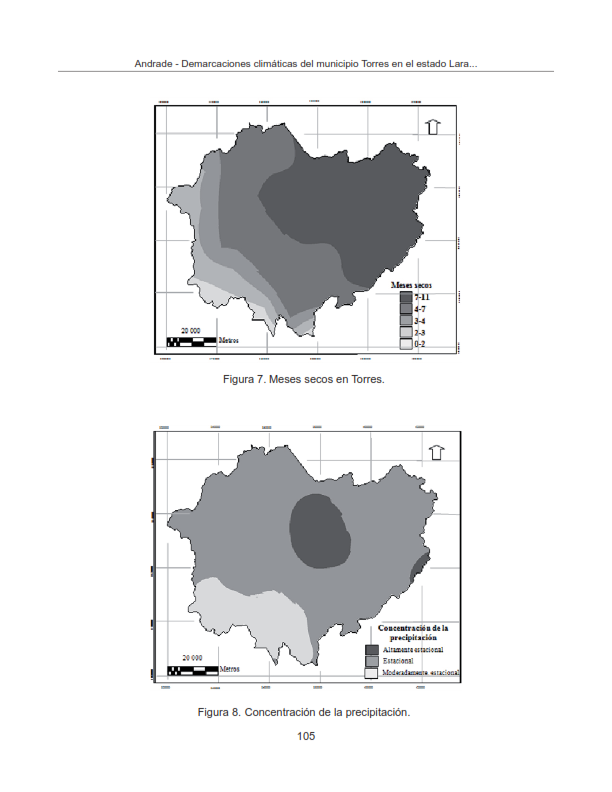Climatic demarcations of the Torres municipality in the Lara state, Venezuela
Abstract
The combined use of geographic information systems (GIS), digital models of elevation (DEM), satellite images, analog and/or digital maps, weather data and field visits is successful in generating information and mapping of elements that define climate. This information is necessary to carry out an assessment of land or when agricultural development is required, especially if it is under rainfed conditions. The objective of this study was to obtain digital maps of climatic elements that allow to define climatic boundaries that exist in the Torres municipality, Lara state. Data from weather stations, technical and mathematical interpolation equations were used to map the elements of the climate. The results indicate that there are four well defined climatic demarcations in the municipality: semi-arid, sub-humid dry, sub-humid humid and humid, which should be considered when develops agricultural area.
Downloads
References
• Arnoldus, H. 1980. An approximation of the rainfall factor in the Universal Soil Loss Equation. In: De Boodt M. y D. Gabriels (Eds). Assessment of erosion. John Wiley and Sons, Inc. Chichester, West Sussex, England. pp. 127-132.
• Basher, L. 1997. Is pedology dead and buried? Australian Journal Soil Research. 35:979-994.
• Burrough, P.1986. Principles Geografical information Systems for land resources assessment. Claredent Press. Oxford, England. 256 p.
• Chuvieco, E. 1996. Fundamentos de teledetección espacial. 3ra Edición. España. 565 p.
• Davidson, D. 2002. The assessment of land resources: achievements and new challenges. Australian Geographical Studies. 40(2):109-128.
• El Pequeño Larousse Ilustrado. 2010. Diccionario enciclopédico. Ediciones Larousse, S.A. Paris. 254 p. ESRI. 2002. Programa ArcView 3.2, versión 3.2a. Environmental System Research Institute, California, USA. Disponible en línea: https://bit.ly/2J0FUCK
• ESRI. 2008. Programa ArcGis 9, version 9.3. Environmental System Research Institute, California, USA. Disponible en línea: https://bit.ly/392Jkj4
• FAO. 1976. A framework for land evaluation. Rome, Italy. Soils Bulletin 32.
• FAO.1983. Guidelines: land evaluation for rainfed agriculture. Rome, Italy. Soils Bulletin. 52.
• FAO.1996. Agro-ecological zoning guidelines. Rome, Italy. Soils Bulletin. 73.
• Ferrer, E. y H. de Paz. 1985. Análisis ambiental de la región centro occidental de Venezuela. FUDECO. Barquisimeto, Lara. 257 p.
• Ferrer, E. 2003. Análisis estructural preliminar de la Hoya del río Tocuyo 2003.1er Parte. Serie Caracterización de la Hoya del Rio Tocuyo. Lara, Venezuela. N°04-04-12-02. 12 p.
• Irvem, A., F. Topaloglu and V. Uygur. 2007. Estimating spatial distribution of soil loss over Seyhan river basin in Turkey. J. Hydrol. 336:30-37.
• Lobo, D. 2005. Guía metodológica para la elaboración del mapa de zonas áridas, semiáridas y subhúmedas secas de América latina y el caribe. 58 p.
• MIP, 1999. Programa MapInfo Profesional 5.5, version 5.5., MapInfo Corporation, USA. Disponible en línea: https://www.mapinfo.com.
• Monkhouse, F. 1978. Diccionario de términos geográficos. Barcelona: oikos-tau, s. a. – ediciones. 94 p.
• Oliver, J. 1980. Monthly precipitation distribution: A comparative index. Professional Geographer.
• 32(3):300-309.
• Páez, M. 1994. Clasificación de suelos por riesgo de erosión hídrica con fines de planificación agrícola. Rev. Fac. Agron. 20:83-100.
• RSI. 2003. Programa ENVI 4.0, versión 4.3. Research System Inc., California, USA. Disponible en línea: https://bit.ly/2U4GmpQ
• Smith, R. E. Ferrer y A. Chávez. 1973. La vegetación actual de la región centro occidental. Boletín Informativo, Suplemento Técnico. FUDECO. Barquisimeto Lara 27 p.
• Thornthwaite, C. 1948. An approach toward a rational classification of climate. American Geographical Society. Geographical Review. 38(1):55-94.
• Unda, J. 2001. Estrategias para la generación de información faltante de suelos en zonas montañosas con fines de evaluación de tierras. Caso: Microcuenca de la Quebrada El Parchal, Edo. Lara. Tesis de Maestría. Postgrado en Ciencia del Suelo. Maracay, Ven. Universidad Central de Venezuela. Facultad de Agronomía. 102 p.
• UNEP. 1997. World atlas of desertification. Second Edition. Middleton N. and Thomas D. (Eds) 182 p.





